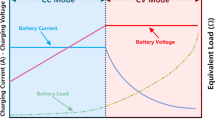Abstract
As an efficient wireless power transmission system for energy storage devices, load-independent output characteristics, zero phase angle and soft switching are required simultaneously. Consequently, a multi-objective parametric design method is proposed based on the output characteristics of the double-sided inductor-capacitor-inductor (LCC) compensation network in this paper. With the proposed method, two output modes of constant current and constant voltage can be implemented at the different resonant frequencies, which reduces the complexity of system control. In addition, the condition of zero phase angle in both modes is proposed. Another contribution of the proposed method is that soft switching in constant current mode and constant voltage mode can be achieved only by designing the compensation capacitor parameters, without any additional control strategy. Finally, in order to verify the correctness and feasibility of the proposed method, a 100 W double-sided LCC compensation network experimental platform is established. The experimental results show that the load-independent output characteristics and near unit power factor operation are achieved during the entire charging process.













Similar content being viewed by others
References
Gao T, Wang X, Jiang L, Hou J, Yang Y (2021) Research on power distribution in multiple-input multiple-output magnetic coupling resonance wireless power transfer system. Electr Eng. https://doi.org/10.1007/s00202-021-01302-9
Kim JG, Kim MH, Ko MS (2021) Study on CCL circuit-based WPT systems in consideration of parasitic resistances of circuit elements. Electr Eng. https://doi.org/10.1007/s00202-021-01292-8
Li K, Zhao H, Liu Q (2021) Design of novel coil structure for wireless power transfer system supporting multi-load and 2-D free-positioning. Electr Eng 103:2009–2020. https://doi.org/10.1007/s00202-020-01210-4
Ke G, Chen Q, Xu L, Ren X, Zhang Z (2021) Analysis and optimization of a double-sided S-LCC hybrid converter for high misalignment tolerance. IEEE Trans Ind Electron 68(6):4870–4881. https://doi.org/10.1109/TIE.2020.2988215
Gati E, Kampitsis G, Manias S (2017) Variable frequency controller for inductive power transfer in dynamic conditions. IEEE Trans Power Electron 32(2):1684–1696. https://doi.org/10.1109/TPEL.2016.2555963
Jiang Y, Wang L, Wang Y, Liu J, Wu M, Ning G (2019) Analysis, design, and implementation of WPT system for EV’s battery charging based on optimal operation frequency range. IEEE Trans Power Electron 34(7):6890–6905. https://doi.org/10.1109/TPEL.2018.2873222
Liu Y, Madawala UK, Mai R, He Z (2020) An optimal multivariable control strategy for inductive power transfer systems to improve efficiency. IEEE Trans Power Electron 35(9):8998–9010. https://doi.org/10.1109/TPEL.2020.2970780
Kim M, Joo D, Lee BK (2019) Design and control of inductive power transfer system for electric vehicles considering wide variation of output voltage and coupling coefficient. IEEE Trans Power Electron 34(2):1197–1208. https://doi.org/10.1109/TPEL.2018.2835161
Calderon-Lopez G, Scoltock J, Wang Y, Laird I, Yuan X, Forsyth AJ (2019) Power-dense bi-directional DC–DC converters with high-performance inductors. IEEE Trans Veh Technol 64(6):2261–2273. https://doi.org/10.1109/TVT.2019.2943124
Huang Z, Wong S, Tse CK (2018) Control design for optimizing efficiency in inductive power transfer systems. IEEE Trans Power Electron 33(5):4523–4534. https://doi.org/10.1109/TPEL.2017.2724039
Wang D, Qu X, Yao Y, Yang P (2021) Hybrid inductive-power-transfer battery chargers for electric vehicle on board charging with configurable charging profile. IEEE Trans Intell Transp Syst 22(1):592–599. https://doi.org/10.1109/TITS.2020.2976647
Chen Y (2020) Variable-parameter T-circuit-based IPT system charging battery with constant current or constant voltage output. IEEE Trans Power Electron 35(2):4523–4534. https://doi.org/10.1109/TPEL.2019.2920948
Qu X, Han H, Wong S-C, Tse CK, Chen W (2015) Hybrid IPT topologies with constant current or constant voltage output for battery charging applications. IEEE Trans Power Electron 30(1):6329–6337. https://doi.org/10.1109/TPEL.2015.2396471
Mai R, Chen Y, Li Y, Zhang Y, Cao G, He Z (2017) Inductive power transfer for massive electric bicycles charging based on hybrid topology switching with a single inverter. IEEE Trans Power Electron 32(8):5897–5906. https://doi.org/10.1109/TPEL.2017.2654360
Lu J, Zhu G, Lin D, Wong S, Jiang J (2017) Load-independent voltage and current transfer characteristics of high-order resonant network in IPT system. IEEE J Emerg Sel Top Power Electron 7(1):422–436. https://doi.org/10.1109/JESTPE.2018.2823782
Zhang W, Mi CC (2016) Compensation topologies of high-power wireless power transfer systems. IEEE Trans Veh Technol 65(6):4768–4778. https://doi.org/10.1109/TVT.2015.2454292
Li S, Li W, Deng J (2015) A double-sided LCC compensation network and its tuning method for wireless power transfer. IEEE Trans Veh Technol 64(6):2261–2273. https://doi.org/10.1109/TVT.2014.2347006
Li Y, Hu J, Chen F, Liu S, Yan Z, He Z (2018) A new-variable-coil-structure-based IPT system with load-independent constant output current or voltage for charging electric bicycles. IEEE Trans Power Electron 33(10):8226–8230. https://doi.org/10.1109/TPEL.2018.2812716
Song K, Li Z, Jiang J (2018) Constant current/voltage charging operation for series-series and series-parallel compensated wireless power transfer systems employing primary-side controller. IEEE Trans Power Electron 33(9):8065–8080. https://doi.org/10.1109/TPEL.2017.2767099
Lu J, Zhu G, Lin D (2019) Load-independent voltage and current transfer characteristics of high-order resonant network in IPT system. IEEE J Emerg Sel Topice Power Electron 7(1):422–436. https://doi.org/10.1109/JESTPE.2018.2823782
Author information
Authors and Affiliations
Corresponding author
Additional information
Publisher's Note
Springer Nature remains neutral with regard to jurisdictional claims in published maps and institutional affiliations.
Rights and permissions
About this article
Cite this article
Li, J., Zhang, X. & Tong, X. A multi-objective-based parametric design method for WPT systems with double-sided LCC compensation network. Electr Eng 104, 2197–2204 (2022). https://doi.org/10.1007/s00202-021-01479-z
Received:
Accepted:
Published:
Issue Date:
DOI: https://doi.org/10.1007/s00202-021-01479-z




